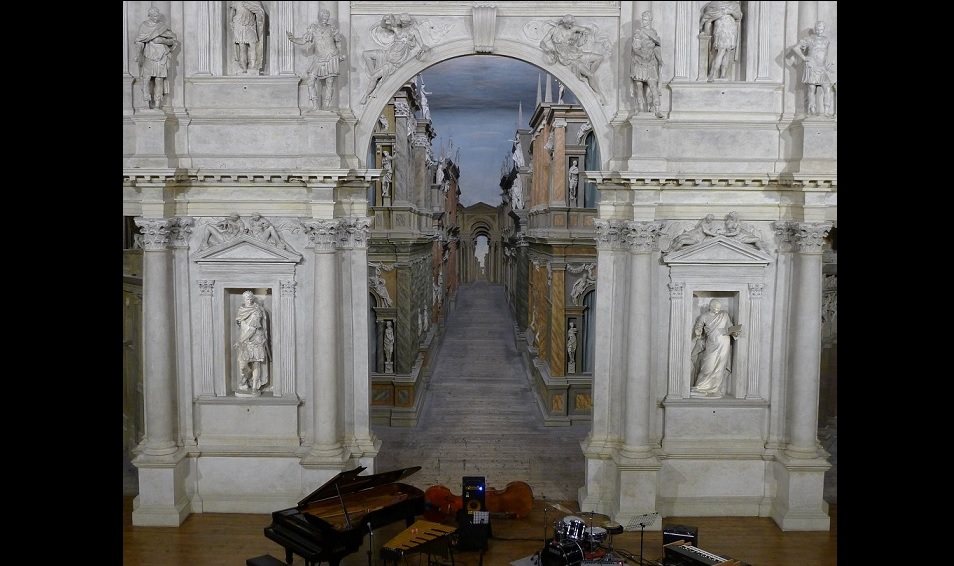藝術議題
- 藝術與公義最新的專題文章如下。如欲閱讀有關同一議題的其他文章,可再點擊右下角資料庫的年份和月份。
關於啟發 | On being inspired
約翰百德 (John BATTEN)
at 5:15pm on 25th July 2019


.jpg)
圖片說明:
1. 帕拉迪奧的奧林匹克劇院內部
2. 選民登記招募行動
3. 默默地把鮮花移往太古廣場外
圖片由作者提供
Caption:
1. Interior of Palladio''s Teatro Olimpico
2. Voter registration recruitment
3. Quietly moving flowers outside Pacific Place.
All photos: John Batten
(Please scroll down for English version)
在我最近的意大利之旅中,我探訪了位於威尼斯60公里外的小城維琴察。我是專程來拜訪建築巨匠安德烈亞.帕拉迪奧的16世紀作品,他的建築設計影響深遠,除了可見於17及18世紀的歐洲、美洲,令人意外的,是近年很多在中國內地落成的公共建築上也可找到。帕拉迪奧最早獲委約的工程項目都在維琴察,不少出自他手筆的宮殿和鄉郊別墅都人選聯合國教科文組織的世界文化遺產。
維琴察於1404年歸威尼斯管轄,但在整個16世紀期間,維琴察憑藉種植桑樹、養蠶和生產絲綢,令城市財富不斷增長,絲綢產品中有一半出口至意大利境外,特別是法國的里昂。經濟繁榮令小城受惠,包括手上擁有過剩現金可供借貸的銀行家。與此同時,威尼斯共和國鼓勵農業生產,希望藉此以減低對進口食品的依賴。維琴察的富裕家庭在市區範圍興建新的宮殿,並把自己手持的農地連同新建莊園別墅整合––當中很多都由帕拉迪奧設計。
帕拉迪奧於1524年由鄰近的帕多瓦來到維琴察,當時只有16歲,最初從事打造紀念雕塑的石匠工作。年輕的帕拉迪奧擁有凡事發問的思維和抱負,他來到了一個充滿生氣、文化氣息濃厚,並反映文藝復興精神的社會環境。在市內的知識份子介紹下,帕拉迪奧認識了古希臘與羅馬建築,繼而發展出自己在古典建築啟發下的設計。他的早期工作,由興建營造跨界發展到設計和建築領域,而且以低成本方案聞名。舉例來說,他以蓋上威尼斯石膏飾面的木和磚營造雲石效果,取代了昂貴的石材,自此成為了業內常用的技術方案。
我在維琴察漫步,探訪帕拉迪奧的建築物,每一幢都展現出創新的設計意念。於1592年落成的圓廳別墅,據稱是他筆下最著名的建築物,這座對稱的建築物位於郊外的小丘上,氣勢媲美神殿。它的精簡形態由一個立方體和一個四角面向東南西北的球體穹頂組成。帕拉迪奧的圓廳別墅是很多建築的參考藍本,其中最有名的,要數湯瑪斯.傑佛遜位於維吉尼亞,重新構想的蒙提薩羅故居(1772)。
然而,令我得到最大啟發的,卻是帕拉迪奧的奧林匹克劇院。這座劇院是在1580年他臨終前的最後設計,後來由侍祭兼建築師文森諾.斯卡莫齊於1585年完成。希臘的底比斯是帕拉迪奧設計劇院時的靈感之源,因此,劇院內部擺放了一排排古典雕塑(是木製仿雲石!)還有半圓形的觀眾座位。斯卡莫齊在原址設計了獨特的木造舞台,複製出遠眺大街小巷的視覺。這是現存的最古老舞台,位於世界上最古老的有蓋劇院。只有一個詞語可以形容我當時的心情:深受啟發。
親眼看到帕拉迪奧的建築,是我意大利之行的一大亮點。即使我已回港兩個月,它仍然令我感到精神一振,深受啟發。但是,最近回到家裡,我也看到和體會到令我感到深受啟發的類似事情。2019年6月19日星期日,200萬+1位市民上街反對《逃犯條例》,這件大事已成為歷史上的印記。然而,個別故事與小情節卻有更大個人意義。對我來說的,包括:
有視頻拍下了救護車穿過民眾時,參與遊行人士像摩西分紅海般讓它通過。我是也是迅速移動讓救護車通行的其中一人,但烙在我腦中的,卻是民眾向救護車和救護員工作致敬的掌聲。
在遊行的較早時間,我一直手持電話,希望找出身在附近卻未見其身影的朋友。我站在軒尼斯道路中的花槽,民眾指向我,並以手勢指示,令我的朋友可以更容易找到我––當他與我會合時,周圍都是笑臉。
遊行期間,我和一些為其他市民進行選民登記的年輕學生聊天。他們是嶺南大學的學生,本身互不認識,但卻自願走出來站在遊行隊伍之中,手上拿著文件夾和登記表格,鼓勵合資格而未登記成為選民的人士登記。那天完結的時候,他們已派出了6,000份表格。在協助推進民主而言,這行動來得多麼簡單、正面和必要。
我在6月17日那天重返添馬艦時,目睹了最令人印像深刻的舉措。當我早上途經太古廣場時,路邊擺滿了遊行隊伍前一天路過時留下、數以千計的鮮花,向早前嘗試懸掛反逃犯條例橫幅時從太古廣場高場墮下身亡的梁凌杰(「+1」)弔唁。到了下午,身穿校服的學生、年輕的示威者和路過途人自發地、安靜地收起鮮花,安靜地把它們移到更靠近事發地點的路面,這位「+1」者的臨時祭壇附近,再把其他物件移走,以示恭敬。
真是啟發人心!
原文刊於《明報周刊》,2019年7月6日
On being inspired
by John Batten
On my recent trip to Italy, I visited the small city of Vicenza, located 60 kilometres from Venice. I had come to see the 16th century architecture of Andrea Palladio, whose designs were to be so influential throughout 17th and 18th century Europe, the Americas and – oddly – now seen in many recently constructed civic buildings throughout the mainland. Palladio’s earliest commissions were in Vicenza and his palaces and country villas are listed by UNESCO as a World Heritage Site.
Vicenza came under the rule of Venice in 1404, but its own wealth grew throughout the 16th-century with the cultivation of mulberry trees, silkworms and the production of silk cloth – half of which was exported outside Italy, particularly to Lyon in France. This economic prosperity benefited the city, including its bankers who had surplus cash to lend. Concurrently, the Venetian republic encouraged agricultural production to reduce its dependence on imported food. Vicenza’s wealthy families built new palaces in the city’s urban areas and consolidated their agricultural land holdings complemented by newly built villas – many designed by Palladio.
Palladio arrived in Vicenza in 1524, aged 16 years old, from nearby Padova to initially work as a stonemason on monumental sculpture. As a young man with an enquiring mind and ambition, Palladio joined a vibrant, culturally rich, social environment that reflected the spirit of the Renaissance. Introduced by the city’s intellectuals to classical Greek and Roman architecture, Palladio developed his own classically inspired designs. His early work crossed from construction into design and architecture and he was known for low cost solutions - for example, he replaced expensive stone with wood and brick which were then coated with marmorino (marble plaster) to replicate marble – a common technical solution thereafter.
I walked around Vicenza visiting Palladio’s buildings – all have innovative design ideas. Arguably his most famous building is the Villa La Rotonda (completed 1592), a symmetrical building placed atop a countryside hill and displaying a temple-like presence. Its stripped-down form comprises of a cube and a sphere with corners orientated to the four compass points. Palladio’s Villa La Rotonda was much-copied, most famously re-envisioned in Thomas Jefferson’s home of Monticello (1772) in Virginia.
However, it was inside Palladio''s Teatro Olimpico that I felt the greatest inspiration. The theatre was his final design before his death in 1580 and completed by an acolyte, architect Vincenzo Scamozzi in 1585. Thebes in Greece was Palladio’s own inspiration for the theatre, so the theatre’s interior has rows of classical sculpture (wooden, but imitating marble!) and a semi-circular bank of seating for the audience. Scamozzi designed the unique in-situ wooden stage that replicates perspective with streets receding to a distant horizon. This is the oldest surviving stage set in existence, in the world''s oldest roofed theatre. Only one word can describe it: inspiring.
Seeing Palladio’s architecture was one of the highlights of my trip to Italy. It uplifted me and still, two months after my return, I feel inspired. But, back home, recently, I have seen and experienced similar inspiring events. Etched now in history, will be the 2,000,000 + 1 people who marched against the extradition legislation on Sunday, 16 June 2019. However, individual stories and small episodes give greater personal meaning. Some of mine include:
There is video footage of an ambulance making its way through the crowds, the marchers parting as Moses parted the Red Sea. I was one of those that moved quickly to allow the ambulance to pass, but what sticks in my mind was the crowd’s clapping in appreciation for the ambulance and the work of its attendants.
Earlier in the march, I was on my phone trying to locate a friend who was nearby but unseen. I was standing on a Hennessy Road plant divider, and the crowd pointed and gesticulated to me so my friend could easily find me – it was smiles from everyone when he joined me.
On the march I chatted to young students who were registering people to vote. They were students from Lignan University, unknown to each other, but who volunteered to stand in the middle of the march, clipboard and registration forms in hand, to encourage eligible non-registered voters to register. By the end of the day, they had handed out 6,000 forms. It was such a simple, positive, and necessary action to assist democracy’s cause.
The most overwhelmingly poignant gesture I witnessed was on 17 June, when I returned to Tamar. As I passed Pacific Place in the morning, the thousands of flowers that had been placed on the side of the road during the previous day’s rally were still there - in tribute to Leung Ling-kit (“+1”) who had died falling from Pacific Place while hanging an anti-extradition banner. In the afternoon, students in uniform, young protesters and passersby spontaneously, in silence, collected the flowers and quietly placed them off the road to nearer the spot, near the temporary shrine of “+1”, while other objects were respectfully removed.
Inspiring!
This article was originally published in Ming Pao Weekly on 6 July 2019. Translated from the original English by Aulina Chan.
